The Dome of the Rock: Purpose, Influences, and Architectural Analysis
VerifiedAdded on 2023/06/15
|11
|3271
|257
Essay
AI Summary
This essay delves into the Dome of the Rock, a significant Islamic monument constructed in Jerusalem by the Umayyad Caliph Abd al-Malik ibn Marwan in the late 7th century. It examines the various explanations for its construction, including its role as a commemoration of Prophet Muhammad's night journey, a representation of Islam's relationship with Christianity and Judaism, and a political statement against Islamic rivals. The essay further analyzes the architectural and decorative innovations of the Dome of the Rock, highlighting its Byzantine influences, unique visual style, mosaics, inscriptions, and the preservation and restoration efforts by various Islamic dynasties. It emphasizes the Dome's symbolic importance as a representation of Islam's triumph and its connection to sacred events, while also acknowledging the ongoing debates surrounding its original function and meaning. The essay makes use of scholarly sources to provide a comprehensive overview of the Dome of the Rock's historical, religious, and architectural significance.

The purpose, influences evident as well
as the architectural and decorative
innovations of “The Dome of the Rock”
as the architectural and decorative
innovations of “The Dome of the Rock”
Paraphrase This Document
Need a fresh take? Get an instant paraphrase of this document with our AI Paraphraser
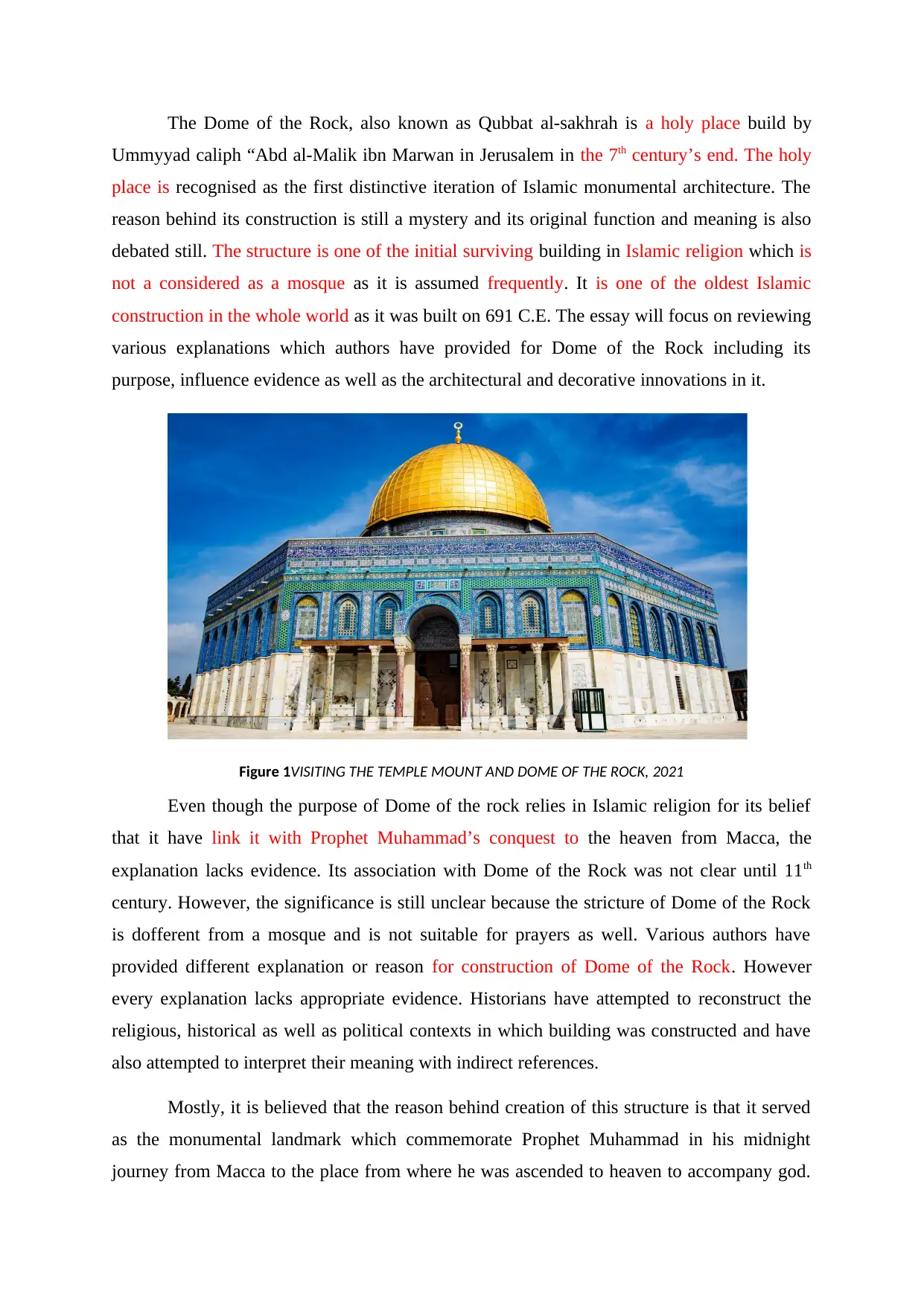
The Dome of the Rock, also known as Qubbat al-sakhrah is a holy place build by
Ummyyad caliph “Abd al-Malik ibn Marwan in Jerusalem in the 7th century’s end. The holy
place is recognised as the first distinctive iteration of Islamic monumental architecture. The
reason behind its construction is still a mystery and its original function and meaning is also
debated still. The structure is one of the initial surviving building in Islamic religion which is
not a considered as a mosque as it is assumed frequently. It is one of the oldest Islamic
construction in the whole world as it was built on 691 C.E. The essay will focus on reviewing
various explanations which authors have provided for Dome of the Rock including its
purpose, influence evidence as well as the architectural and decorative innovations in it.
Figure 1VISITING THE TEMPLE MOUNT AND DOME OF THE ROCK, 2021
Even though the purpose of Dome of the rock relies in Islamic religion for its belief
that it have link it with Prophet Muhammad’s conquest to the heaven from Macca, the
explanation lacks evidence. Its association with Dome of the Rock was not clear until 11th
century. However, the significance is still unclear because the stricture of Dome of the Rock
is dofferent from a mosque and is not suitable for prayers as well. Various authors have
provided different explanation or reason for construction of Dome of the Rock. However
every explanation lacks appropriate evidence. Historians have attempted to reconstruct the
religious, historical as well as political contexts in which building was constructed and have
also attempted to interpret their meaning with indirect references.
Mostly, it is believed that the reason behind creation of this structure is that it served
as the monumental landmark which commemorate Prophet Muhammad in his midnight
journey from Macca to the place from where he was ascended to heaven to accompany god.
Ummyyad caliph “Abd al-Malik ibn Marwan in Jerusalem in the 7th century’s end. The holy
place is recognised as the first distinctive iteration of Islamic monumental architecture. The
reason behind its construction is still a mystery and its original function and meaning is also
debated still. The structure is one of the initial surviving building in Islamic religion which is
not a considered as a mosque as it is assumed frequently. It is one of the oldest Islamic
construction in the whole world as it was built on 691 C.E. The essay will focus on reviewing
various explanations which authors have provided for Dome of the Rock including its
purpose, influence evidence as well as the architectural and decorative innovations in it.
Figure 1VISITING THE TEMPLE MOUNT AND DOME OF THE ROCK, 2021
Even though the purpose of Dome of the rock relies in Islamic religion for its belief
that it have link it with Prophet Muhammad’s conquest to the heaven from Macca, the
explanation lacks evidence. Its association with Dome of the Rock was not clear until 11th
century. However, the significance is still unclear because the stricture of Dome of the Rock
is dofferent from a mosque and is not suitable for prayers as well. Various authors have
provided different explanation or reason for construction of Dome of the Rock. However
every explanation lacks appropriate evidence. Historians have attempted to reconstruct the
religious, historical as well as political contexts in which building was constructed and have
also attempted to interpret their meaning with indirect references.
Mostly, it is believed that the reason behind creation of this structure is that it served
as the monumental landmark which commemorate Prophet Muhammad in his midnight
journey from Macca to the place from where he was ascended to heaven to accompany god.
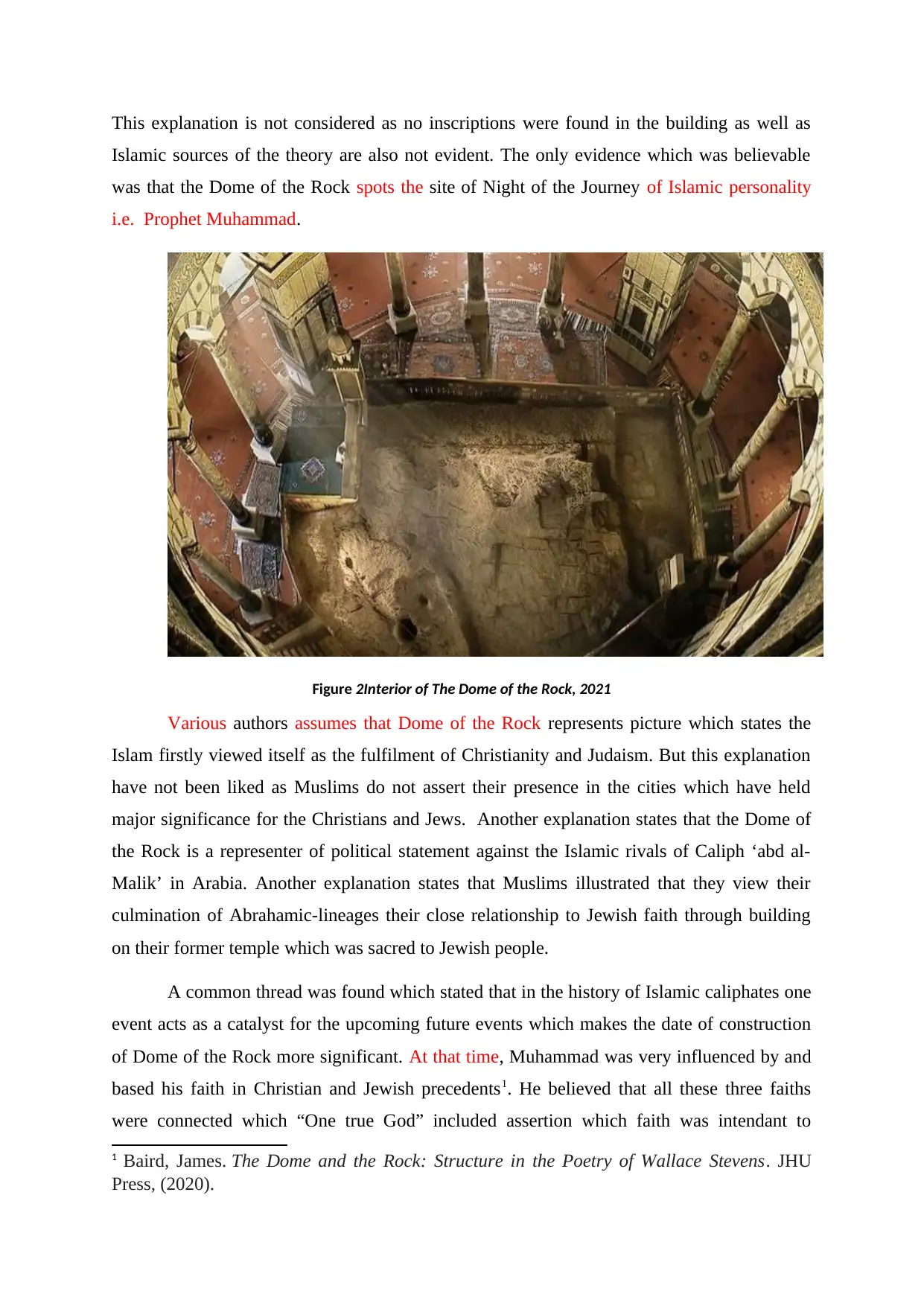
This explanation is not considered as no inscriptions were found in the building as well as
Islamic sources of the theory are also not evident. The only evidence which was believable
was that the Dome of the Rock spots the site of Night of the Journey of Islamic personality
i.e. Prophet Muhammad.
Figure 2Interior of The Dome of the Rock, 2021
Various authors assumes that Dome of the Rock represents picture which states the
Islam firstly viewed itself as the fulfilment of Christianity and Judaism. But this explanation
have not been liked as Muslims do not assert their presence in the cities which have held
major significance for the Christians and Jews. Another explanation states that the Dome of
the Rock is a representer of political statement against the Islamic rivals of Caliph ‘abd al-
Malik’ in Arabia. Another explanation states that Muslims illustrated that they view their
culmination of Abrahamic-lineages their close relationship to Jewish faith through building
on their former temple which was sacred to Jewish people.
A common thread was found which stated that in the history of Islamic caliphates one
event acts as a catalyst for the upcoming future events which makes the date of construction
of Dome of the Rock more significant. At that time, Muhammad was very influenced by and
based his faith in Christian and Jewish precedents1. He believed that all these three faiths
were connected which “One true God” included assertion which faith was intendant to
1 Baird, James. The Dome and the Rock: Structure in the Poetry of Wallace Stevens. JHU
Press, (2020).
Islamic sources of the theory are also not evident. The only evidence which was believable
was that the Dome of the Rock spots the site of Night of the Journey of Islamic personality
i.e. Prophet Muhammad.
Figure 2Interior of The Dome of the Rock, 2021
Various authors assumes that Dome of the Rock represents picture which states the
Islam firstly viewed itself as the fulfilment of Christianity and Judaism. But this explanation
have not been liked as Muslims do not assert their presence in the cities which have held
major significance for the Christians and Jews. Another explanation states that the Dome of
the Rock is a representer of political statement against the Islamic rivals of Caliph ‘abd al-
Malik’ in Arabia. Another explanation states that Muslims illustrated that they view their
culmination of Abrahamic-lineages their close relationship to Jewish faith through building
on their former temple which was sacred to Jewish people.
A common thread was found which stated that in the history of Islamic caliphates one
event acts as a catalyst for the upcoming future events which makes the date of construction
of Dome of the Rock more significant. At that time, Muhammad was very influenced by and
based his faith in Christian and Jewish precedents1. He believed that all these three faiths
were connected which “One true God” included assertion which faith was intendant to
1 Baird, James. The Dome and the Rock: Structure in the Poetry of Wallace Stevens. JHU
Press, (2020).
⊘ This is a preview!⊘
Do you want full access?
Subscribe today to unlock all pages.

Trusted by 1+ million students worldwide

supplant other two. This provides the reason for Muhammad and his successor’s significance
to build Dome of the Rock as an initial architecture2 works.
Figure 3Cave inside the Dome of the Rock. 2021
Muslims believe that the rock on whom the dome is situated is the exact place from
where Prophet Mohammad had escorted to heaven to face the true god. There is Al-Aqsa
Mosque nearby the southern extreme of the plaza. Muslims believe that it the place from
which Muhammad was transported miraculously from Mecca on his journey of the night to
heaven. ‘Al-Aqsa Mosque’ is also used to refer to Dome of the Rock.
Various people assumes that the Dome of the Rock means more than a structure to
Muslims. Since its creation, the structure is a symbol for Triumph of Islam and also a
reminder of unique connections of human to God through various sacred events which occurs
since the creation of the earth. People have cherished the structure for various religious
symbolisms. These religious symbolisms have given raise to the literature which is as known
as ‘Fada il al-Quds’ the Dome of Rock is also a represents evidence of emergence of Islam
religion as well as also explains how the early Muslims have shaped their religious identity
and vis-à-vis their monotheist cousins such as Christians and Muslims3.
2 Levy-Rubin, Milka. "Why was the Dome of the Rock built? A new perspective on a long-
discussed question." Bulletin of the School of Oriental and African Studies 80. no. 3 (2017):
441-464.
to build Dome of the Rock as an initial architecture2 works.
Figure 3Cave inside the Dome of the Rock. 2021
Muslims believe that the rock on whom the dome is situated is the exact place from
where Prophet Mohammad had escorted to heaven to face the true god. There is Al-Aqsa
Mosque nearby the southern extreme of the plaza. Muslims believe that it the place from
which Muhammad was transported miraculously from Mecca on his journey of the night to
heaven. ‘Al-Aqsa Mosque’ is also used to refer to Dome of the Rock.
Various people assumes that the Dome of the Rock means more than a structure to
Muslims. Since its creation, the structure is a symbol for Triumph of Islam and also a
reminder of unique connections of human to God through various sacred events which occurs
since the creation of the earth. People have cherished the structure for various religious
symbolisms. These religious symbolisms have given raise to the literature which is as known
as ‘Fada il al-Quds’ the Dome of Rock is also a represents evidence of emergence of Islam
religion as well as also explains how the early Muslims have shaped their religious identity
and vis-à-vis their monotheist cousins such as Christians and Muslims3.
2 Levy-Rubin, Milka. "Why was the Dome of the Rock built? A new perspective on a long-
discussed question." Bulletin of the School of Oriental and African Studies 80. no. 3 (2017):
441-464.
Paraphrase This Document
Need a fresh take? Get an instant paraphrase of this document with our AI Paraphraser
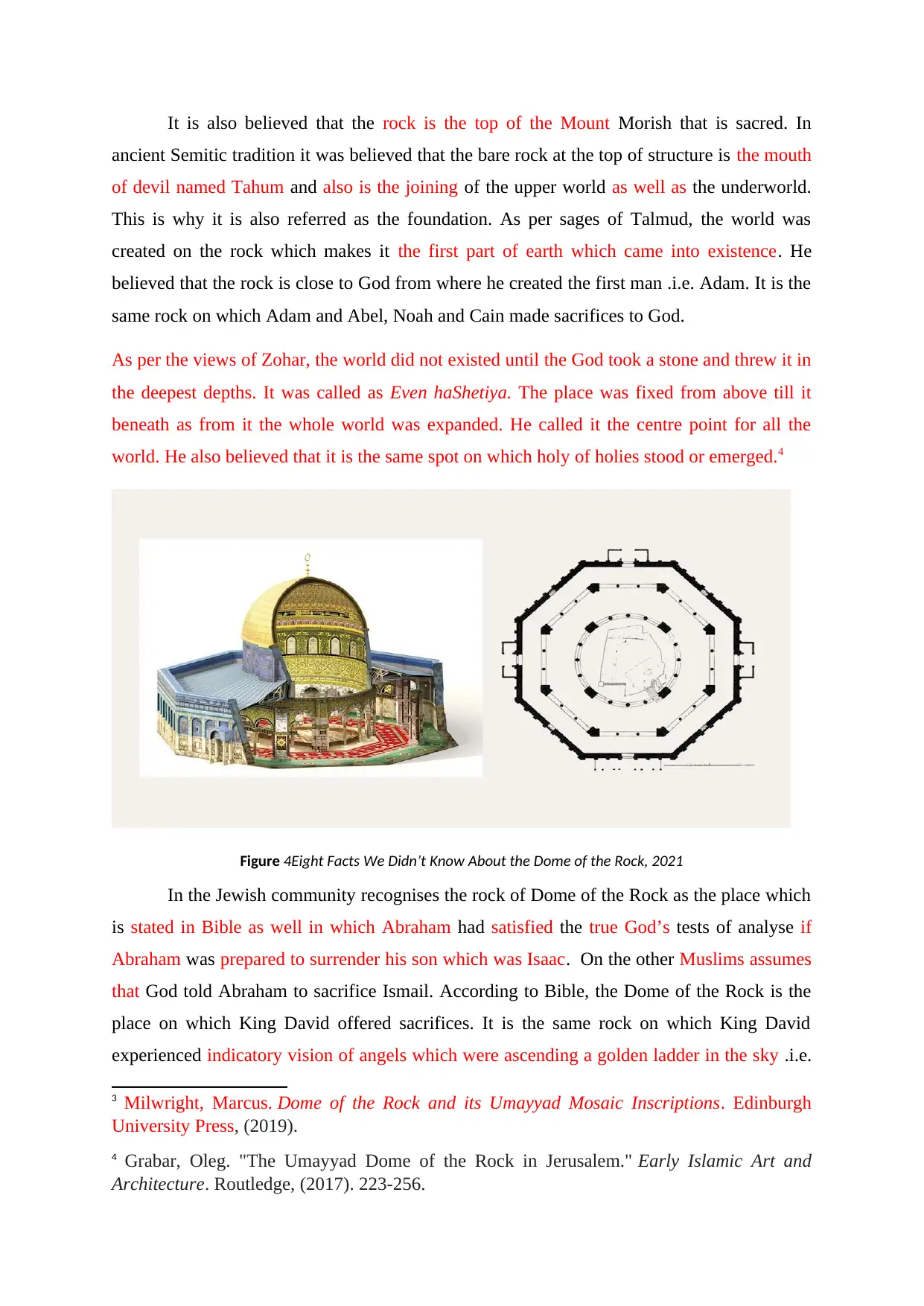
It is also believed that the rock is the top of the Mount Morish that is sacred. In
ancient Semitic tradition it was believed that the bare rock at the top of structure is the mouth
of devil named Tahum and also is the joining of the upper world as well as the underworld.
This is why it is also referred as the foundation. As per sages of Talmud, the world was
created on the rock which makes it the first part of earth which came into existence. He
believed that the rock is close to God from where he created the first man .i.e. Adam. It is the
same rock on which Adam and Abel, Noah and Cain made sacrifices to God.
As per the views of Zohar, the world did not existed until the God took a stone and threw it in
the deepest depths. It was called as Even haShetiya. The place was fixed from above till it
beneath as from it the whole world was expanded. He called it the centre point for all the
world. He also believed that it is the same spot on which holy of holies stood or emerged.4
Figure 4Eight Facts We Didn’t Know About the Dome of the Rock, 2021
In the Jewish community recognises the rock of Dome of the Rock as the place which
is stated in Bible as well in which Abraham had satisfied the true God’s tests of analyse if
Abraham was prepared to surrender his son which was Isaac. On the other Muslims assumes
that God told Abraham to sacrifice Ismail. According to Bible, the Dome of the Rock is the
place on which King David offered sacrifices. It is the same rock on which King David
experienced indicatory vision of angels which were ascending a golden ladder in the sky .i.e.
3 Milwright, Marcus. Dome of the Rock and its Umayyad Mosaic Inscriptions. Edinburgh
University Press, (2019).
4 Grabar, Oleg. "The Umayyad Dome of the Rock in Jerusalem." Early Islamic Art and
Architecture. Routledge, (2017). 223-256.
ancient Semitic tradition it was believed that the bare rock at the top of structure is the mouth
of devil named Tahum and also is the joining of the upper world as well as the underworld.
This is why it is also referred as the foundation. As per sages of Talmud, the world was
created on the rock which makes it the first part of earth which came into existence. He
believed that the rock is close to God from where he created the first man .i.e. Adam. It is the
same rock on which Adam and Abel, Noah and Cain made sacrifices to God.
As per the views of Zohar, the world did not existed until the God took a stone and threw it in
the deepest depths. It was called as Even haShetiya. The place was fixed from above till it
beneath as from it the whole world was expanded. He called it the centre point for all the
world. He also believed that it is the same spot on which holy of holies stood or emerged.4
Figure 4Eight Facts We Didn’t Know About the Dome of the Rock, 2021
In the Jewish community recognises the rock of Dome of the Rock as the place which
is stated in Bible as well in which Abraham had satisfied the true God’s tests of analyse if
Abraham was prepared to surrender his son which was Isaac. On the other Muslims assumes
that God told Abraham to sacrifice Ismail. According to Bible, the Dome of the Rock is the
place on which King David offered sacrifices. It is the same rock on which King David
experienced indicatory vision of angels which were ascending a golden ladder in the sky .i.e.
3 Milwright, Marcus. Dome of the Rock and its Umayyad Mosaic Inscriptions. Edinburgh
University Press, (2019).
4 Grabar, Oleg. "The Umayyad Dome of the Rock in Jerusalem." Early Islamic Art and
Architecture. Routledge, (2017). 223-256.
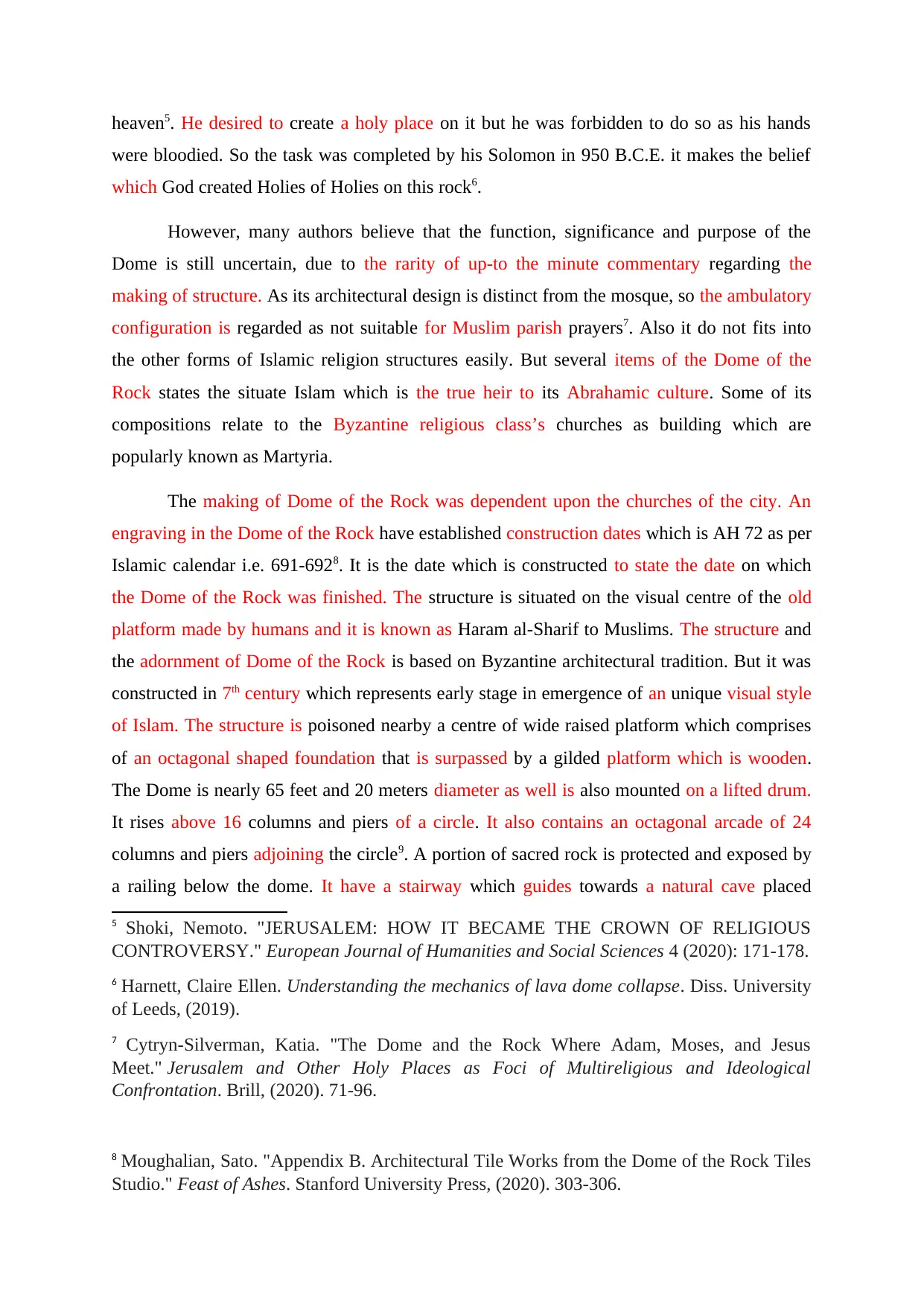
heaven5. He desired to create a holy place on it but he was forbidden to do so as his hands
were bloodied. So the task was completed by his Solomon in 950 B.C.E. it makes the belief
which God created Holies of Holies on this rock6.
However, many authors believe that the function, significance and purpose of the
Dome is still uncertain, due to the rarity of up-to the minute commentary regarding the
making of structure. As its architectural design is distinct from the mosque, so the ambulatory
configuration is regarded as not suitable for Muslim parish prayers7. Also it do not fits into
the other forms of Islamic religion structures easily. But several items of the Dome of the
Rock states the situate Islam which is the true heir to its Abrahamic culture. Some of its
compositions relate to the Byzantine religious class’s churches as building which are
popularly known as Martyria.
The making of Dome of the Rock was dependent upon the churches of the city. An
engraving in the Dome of the Rock have established construction dates which is AH 72 as per
Islamic calendar i.e. 691-6928. It is the date which is constructed to state the date on which
the Dome of the Rock was finished. The structure is situated on the visual centre of the old
platform made by humans and it is known as Haram al-Sharif to Muslims. The structure and
the adornment of Dome of the Rock is based on Byzantine architectural tradition. But it was
constructed in 7th century which represents early stage in emergence of an unique visual style
of Islam. The structure is poisoned nearby a centre of wide raised platform which comprises
of an octagonal shaped foundation that is surpassed by a gilded platform which is wooden.
The Dome is nearly 65 feet and 20 meters diameter as well is also mounted on a lifted drum.
It rises above 16 columns and piers of a circle. It also contains an octagonal arcade of 24
columns and piers adjoining the circle9. A portion of sacred rock is protected and exposed by
a railing below the dome. It have a stairway which guides towards a natural cave placed
5 Shoki, Nemoto. "JERUSALEM: HOW IT BECAME THE CROWN OF RELIGIOUS
CONTROVERSY." European Journal of Humanities and Social Sciences 4 (2020): 171-178.
6 Harnett, Claire Ellen. Understanding the mechanics of lava dome collapse. Diss. University
of Leeds, (2019).
7 Cytryn-Silverman, Katia. "The Dome and the Rock Where Adam, Moses, and Jesus
Meet." Jerusalem and Other Holy Places as Foci of Multireligious and Ideological
Confrontation. Brill, (2020). 71-96.
8 Moughalian, Sato. "Appendix B. Architectural Tile Works from the Dome of the Rock Tiles
Studio." Feast of Ashes. Stanford University Press, (2020). 303-306.
were bloodied. So the task was completed by his Solomon in 950 B.C.E. it makes the belief
which God created Holies of Holies on this rock6.
However, many authors believe that the function, significance and purpose of the
Dome is still uncertain, due to the rarity of up-to the minute commentary regarding the
making of structure. As its architectural design is distinct from the mosque, so the ambulatory
configuration is regarded as not suitable for Muslim parish prayers7. Also it do not fits into
the other forms of Islamic religion structures easily. But several items of the Dome of the
Rock states the situate Islam which is the true heir to its Abrahamic culture. Some of its
compositions relate to the Byzantine religious class’s churches as building which are
popularly known as Martyria.
The making of Dome of the Rock was dependent upon the churches of the city. An
engraving in the Dome of the Rock have established construction dates which is AH 72 as per
Islamic calendar i.e. 691-6928. It is the date which is constructed to state the date on which
the Dome of the Rock was finished. The structure is situated on the visual centre of the old
platform made by humans and it is known as Haram al-Sharif to Muslims. The structure and
the adornment of Dome of the Rock is based on Byzantine architectural tradition. But it was
constructed in 7th century which represents early stage in emergence of an unique visual style
of Islam. The structure is poisoned nearby a centre of wide raised platform which comprises
of an octagonal shaped foundation that is surpassed by a gilded platform which is wooden.
The Dome is nearly 65 feet and 20 meters diameter as well is also mounted on a lifted drum.
It rises above 16 columns and piers of a circle. It also contains an octagonal arcade of 24
columns and piers adjoining the circle9. A portion of sacred rock is protected and exposed by
a railing below the dome. It have a stairway which guides towards a natural cave placed
5 Shoki, Nemoto. "JERUSALEM: HOW IT BECAME THE CROWN OF RELIGIOUS
CONTROVERSY." European Journal of Humanities and Social Sciences 4 (2020): 171-178.
6 Harnett, Claire Ellen. Understanding the mechanics of lava dome collapse. Diss. University
of Leeds, (2019).
7 Cytryn-Silverman, Katia. "The Dome and the Rock Where Adam, Moses, and Jesus
Meet." Jerusalem and Other Holy Places as Foci of Multireligious and Ideological
Confrontation. Brill, (2020). 71-96.
8 Moughalian, Sato. "Appendix B. Architectural Tile Works from the Dome of the Rock Tiles
Studio." Feast of Ashes. Stanford University Press, (2020). 303-306.
⊘ This is a preview!⊘
Do you want full access?
Subscribe today to unlock all pages.

Trusted by 1+ million students worldwide
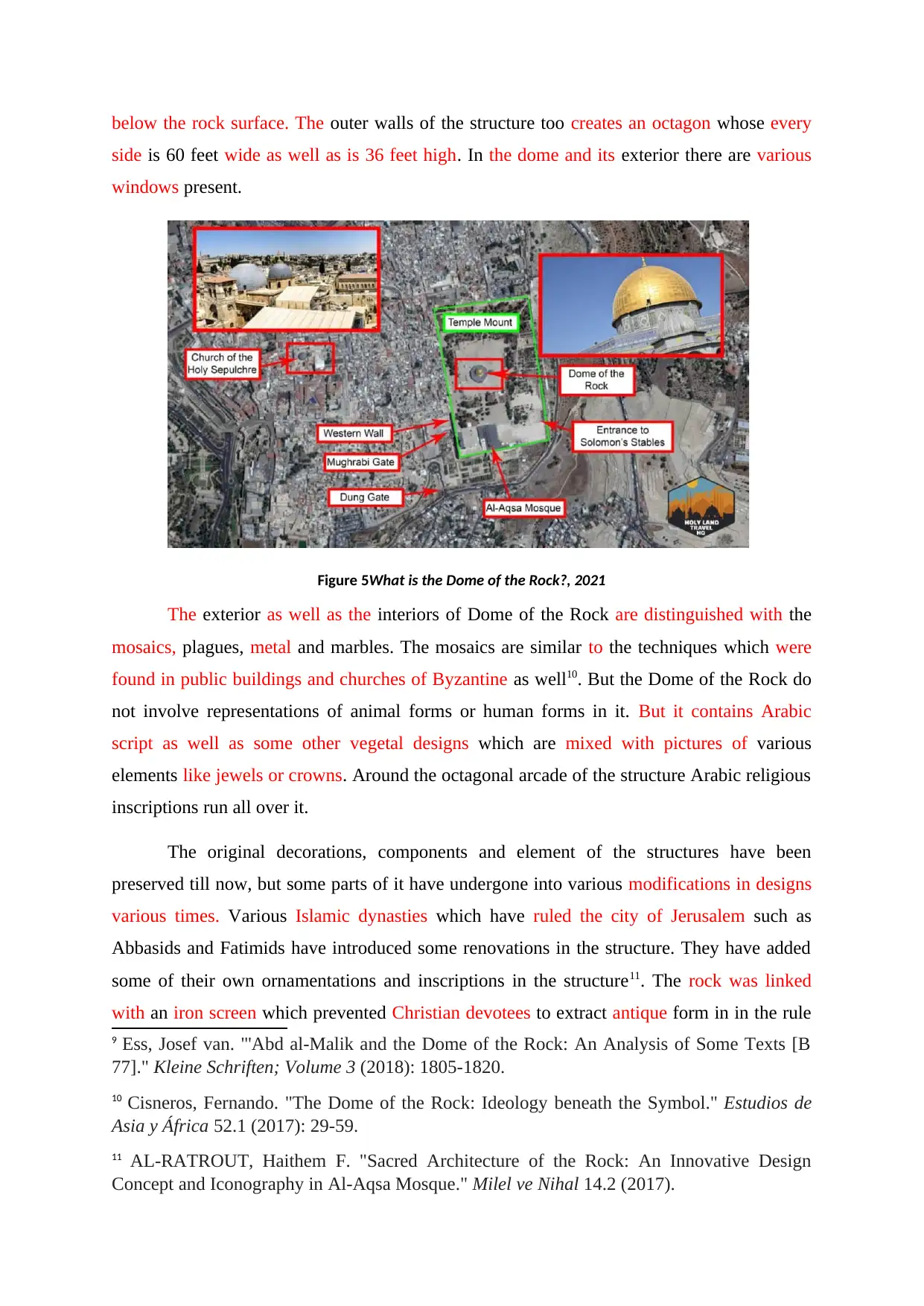
below the rock surface. The outer walls of the structure too creates an octagon whose every
side is 60 feet wide as well as is 36 feet high. In the dome and its exterior there are various
windows present.
Figure 5What is the Dome of the Rock?, 2021
The exterior as well as the interiors of Dome of the Rock are distinguished with the
mosaics, plagues, metal and marbles. The mosaics are similar to the techniques which were
found in public buildings and churches of Byzantine as well10. But the Dome of the Rock do
not involve representations of animal forms or human forms in it. But it contains Arabic
script as well as some other vegetal designs which are mixed with pictures of various
elements like jewels or crowns. Around the octagonal arcade of the structure Arabic religious
inscriptions run all over it.
The original decorations, components and element of the structures have been
preserved till now, but some parts of it have undergone into various modifications in designs
various times. Various Islamic dynasties which have ruled the city of Jerusalem such as
Abbasids and Fatimids have introduced some renovations in the structure. They have added
some of their own ornamentations and inscriptions in the structure11. The rock was linked
with an iron screen which prevented Christian devotees to extract antique form in in the rule
9 Ess, Josef van. "'Abd al-Malik and the Dome of the Rock: An Analysis of Some Texts [B
77]." Kleine Schriften; Volume 3 (2018): 1805-1820.
10 Cisneros, Fernando. "The Dome of the Rock: Ideology beneath the Symbol." Estudios de
Asia y África 52.1 (2017): 29-59.
11 AL-RATROUT, Haithem F. "Sacred Architecture of the Rock: An Innovative Design
Concept and Iconography in Al-Aqsa Mosque." Milel ve Nihal 14.2 (2017).
side is 60 feet wide as well as is 36 feet high. In the dome and its exterior there are various
windows present.
Figure 5What is the Dome of the Rock?, 2021
The exterior as well as the interiors of Dome of the Rock are distinguished with the
mosaics, plagues, metal and marbles. The mosaics are similar to the techniques which were
found in public buildings and churches of Byzantine as well10. But the Dome of the Rock do
not involve representations of animal forms or human forms in it. But it contains Arabic
script as well as some other vegetal designs which are mixed with pictures of various
elements like jewels or crowns. Around the octagonal arcade of the structure Arabic religious
inscriptions run all over it.
The original decorations, components and element of the structures have been
preserved till now, but some parts of it have undergone into various modifications in designs
various times. Various Islamic dynasties which have ruled the city of Jerusalem such as
Abbasids and Fatimids have introduced some renovations in the structure. They have added
some of their own ornamentations and inscriptions in the structure11. The rock was linked
with an iron screen which prevented Christian devotees to extract antique form in in the rule
9 Ess, Josef van. "'Abd al-Malik and the Dome of the Rock: An Analysis of Some Texts [B
77]." Kleine Schriften; Volume 3 (2018): 1805-1820.
10 Cisneros, Fernando. "The Dome of the Rock: Ideology beneath the Symbol." Estudios de
Asia y África 52.1 (2017): 29-59.
11 AL-RATROUT, Haithem F. "Sacred Architecture of the Rock: An Innovative Design
Concept and Iconography in Al-Aqsa Mosque." Milel ve Nihal 14.2 (2017).
Paraphrase This Document
Need a fresh take? Get an instant paraphrase of this document with our AI Paraphraser
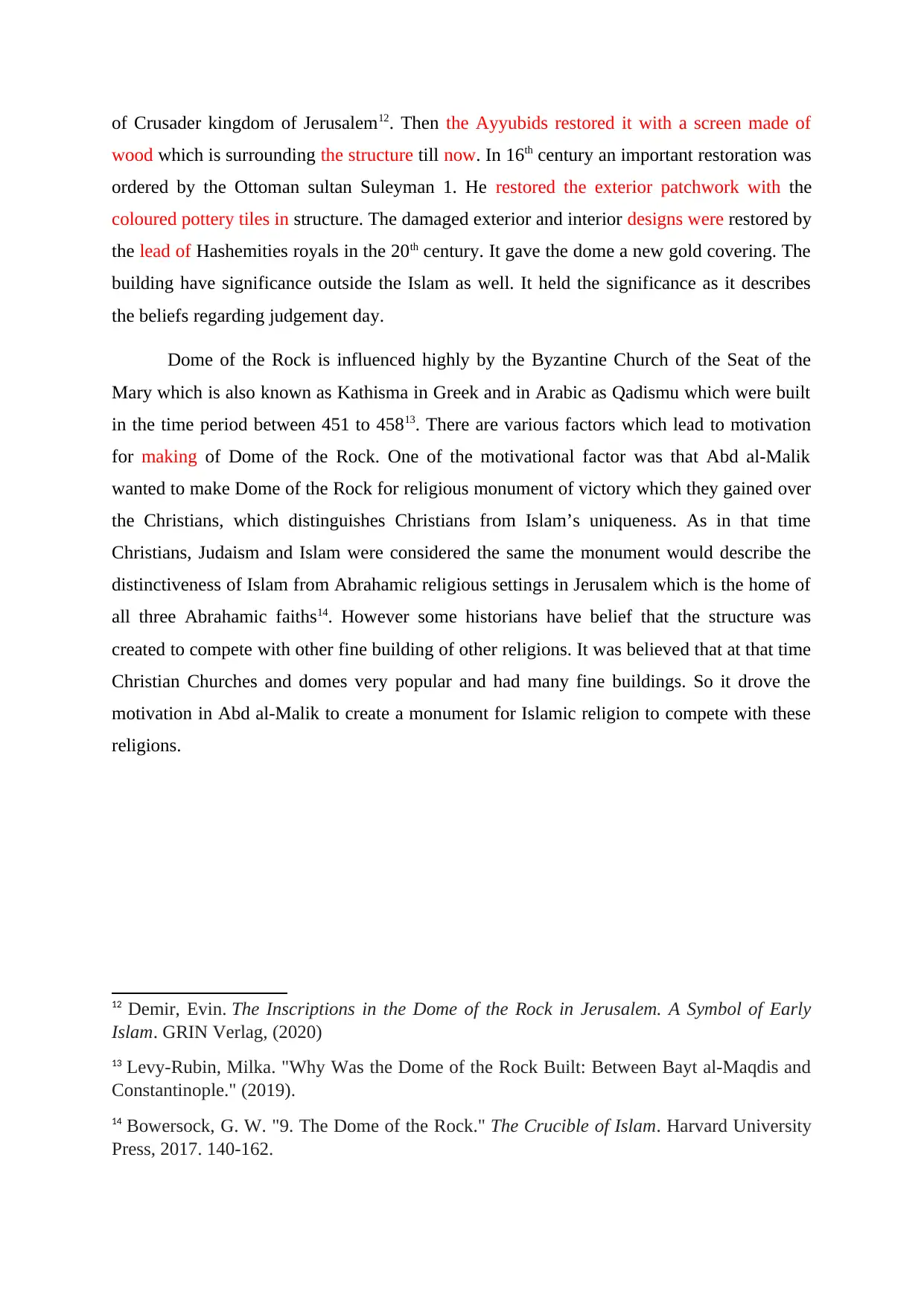
of Crusader kingdom of Jerusalem12. Then the Ayyubids restored it with a screen made of
wood which is surrounding the structure till now. In 16th century an important restoration was
ordered by the Ottoman sultan Suleyman 1. He restored the exterior patchwork with the
coloured pottery tiles in structure. The damaged exterior and interior designs were restored by
the lead of Hashemities royals in the 20th century. It gave the dome a new gold covering. The
building have significance outside the Islam as well. It held the significance as it describes
the beliefs regarding judgement day.
Dome of the Rock is influenced highly by the Byzantine Church of the Seat of the
Mary which is also known as Kathisma in Greek and in Arabic as Qadismu which were built
in the time period between 451 to 45813. There are various factors which lead to motivation
for making of Dome of the Rock. One of the motivational factor was that Abd al-Malik
wanted to make Dome of the Rock for religious monument of victory which they gained over
the Christians, which distinguishes Christians from Islam’s uniqueness. As in that time
Christians, Judaism and Islam were considered the same the monument would describe the
distinctiveness of Islam from Abrahamic religious settings in Jerusalem which is the home of
all three Abrahamic faiths14. However some historians have belief that the structure was
created to compete with other fine building of other religions. It was believed that at that time
Christian Churches and domes very popular and had many fine buildings. So it drove the
motivation in Abd al-Malik to create a monument for Islamic religion to compete with these
religions.
12 Demir, Evin. The Inscriptions in the Dome of the Rock in Jerusalem. A Symbol of Early
Islam. GRIN Verlag, (2020)
13 Levy-Rubin, Milka. "Why Was the Dome of the Rock Built: Between Bayt al-Maqdis and
Constantinople." (2019).
14 Bowersock, G. W. "9. The Dome of the Rock." The Crucible of Islam. Harvard University
Press, 2017. 140-162.
wood which is surrounding the structure till now. In 16th century an important restoration was
ordered by the Ottoman sultan Suleyman 1. He restored the exterior patchwork with the
coloured pottery tiles in structure. The damaged exterior and interior designs were restored by
the lead of Hashemities royals in the 20th century. It gave the dome a new gold covering. The
building have significance outside the Islam as well. It held the significance as it describes
the beliefs regarding judgement day.
Dome of the Rock is influenced highly by the Byzantine Church of the Seat of the
Mary which is also known as Kathisma in Greek and in Arabic as Qadismu which were built
in the time period between 451 to 45813. There are various factors which lead to motivation
for making of Dome of the Rock. One of the motivational factor was that Abd al-Malik
wanted to make Dome of the Rock for religious monument of victory which they gained over
the Christians, which distinguishes Christians from Islam’s uniqueness. As in that time
Christians, Judaism and Islam were considered the same the monument would describe the
distinctiveness of Islam from Abrahamic religious settings in Jerusalem which is the home of
all three Abrahamic faiths14. However some historians have belief that the structure was
created to compete with other fine building of other religions. It was believed that at that time
Christian Churches and domes very popular and had many fine buildings. So it drove the
motivation in Abd al-Malik to create a monument for Islamic religion to compete with these
religions.
12 Demir, Evin. The Inscriptions in the Dome of the Rock in Jerusalem. A Symbol of Early
Islam. GRIN Verlag, (2020)
13 Levy-Rubin, Milka. "Why Was the Dome of the Rock Built: Between Bayt al-Maqdis and
Constantinople." (2019).
14 Bowersock, G. W. "9. The Dome of the Rock." The Crucible of Islam. Harvard University
Press, 2017. 140-162.
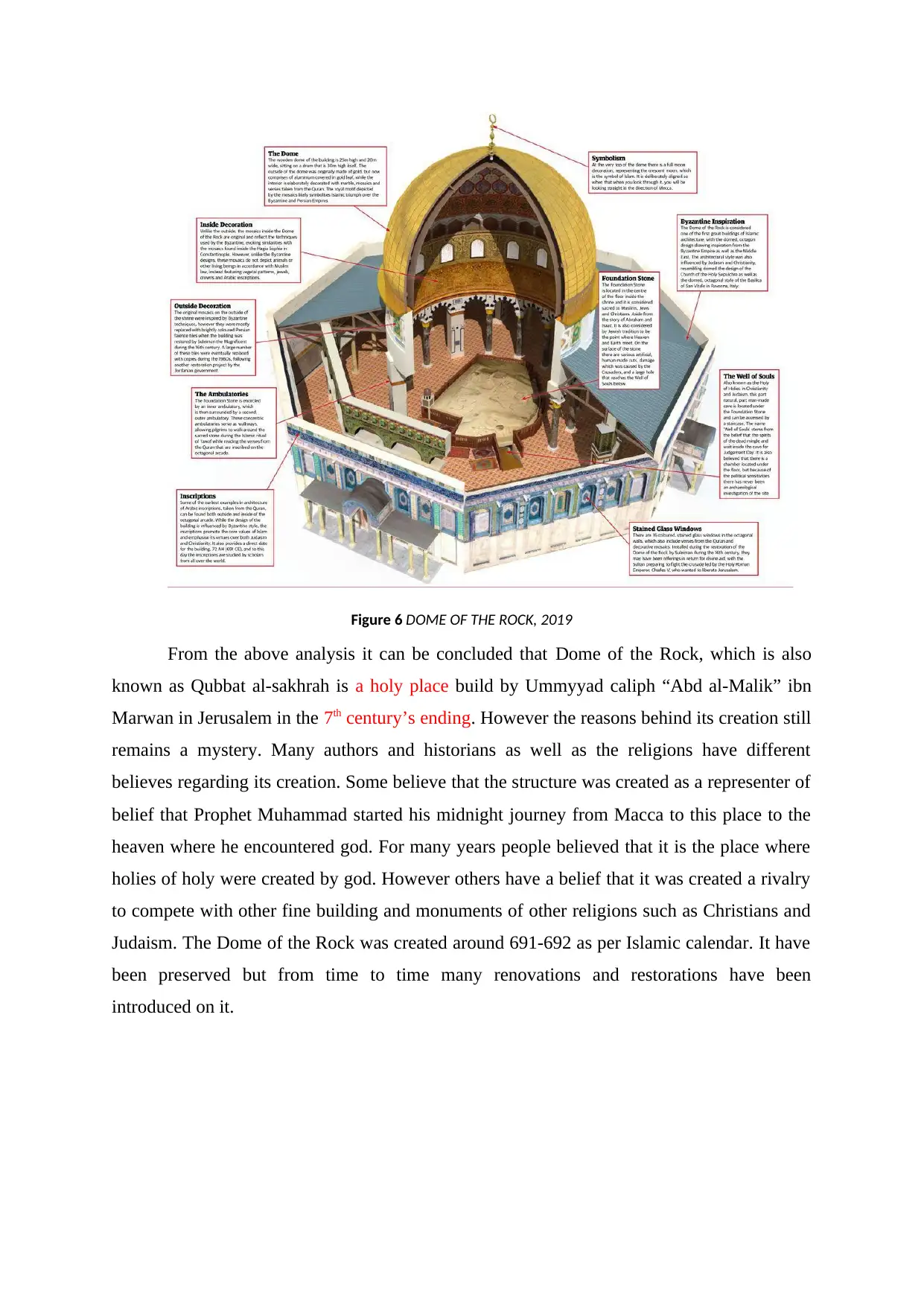
Figure 6 DOME OF THE ROCK, 2019
From the above analysis it can be concluded that Dome of the Rock, which is also
known as Qubbat al-sakhrah is a holy place build by Ummyyad caliph “Abd al-Malik” ibn
Marwan in Jerusalem in the 7th century’s ending. However the reasons behind its creation still
remains a mystery. Many authors and historians as well as the religions have different
believes regarding its creation. Some believe that the structure was created as a representer of
belief that Prophet Muhammad started his midnight journey from Macca to this place to the
heaven where he encountered god. For many years people believed that it is the place where
holies of holy were created by god. However others have a belief that it was created a rivalry
to compete with other fine building and monuments of other religions such as Christians and
Judaism. The Dome of the Rock was created around 691-692 as per Islamic calendar. It have
been preserved but from time to time many renovations and restorations have been
introduced on it.
From the above analysis it can be concluded that Dome of the Rock, which is also
known as Qubbat al-sakhrah is a holy place build by Ummyyad caliph “Abd al-Malik” ibn
Marwan in Jerusalem in the 7th century’s ending. However the reasons behind its creation still
remains a mystery. Many authors and historians as well as the religions have different
believes regarding its creation. Some believe that the structure was created as a representer of
belief that Prophet Muhammad started his midnight journey from Macca to this place to the
heaven where he encountered god. For many years people believed that it is the place where
holies of holy were created by god. However others have a belief that it was created a rivalry
to compete with other fine building and monuments of other religions such as Christians and
Judaism. The Dome of the Rock was created around 691-692 as per Islamic calendar. It have
been preserved but from time to time many renovations and restorations have been
introduced on it.
⊘ This is a preview!⊘
Do you want full access?
Subscribe today to unlock all pages.

Trusted by 1+ million students worldwide
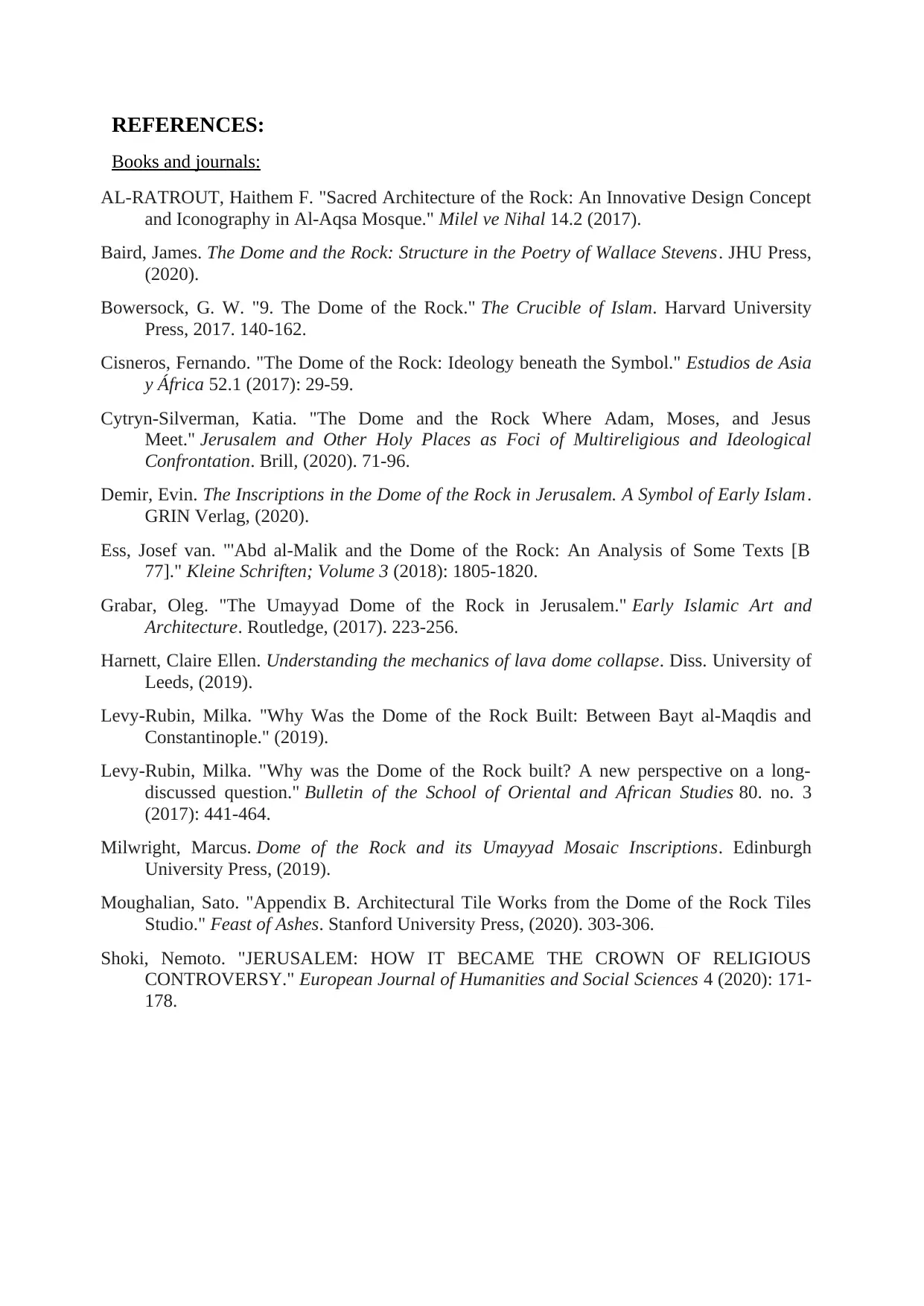
REFERENCES:
Books and journals:
AL-RATROUT, Haithem F. "Sacred Architecture of the Rock: An Innovative Design Concept
and Iconography in Al-Aqsa Mosque." Milel ve Nihal 14.2 (2017).
Baird, James. The Dome and the Rock: Structure in the Poetry of Wallace Stevens. JHU Press,
(2020).
Bowersock, G. W. "9. The Dome of the Rock." The Crucible of Islam. Harvard University
Press, 2017. 140-162.
Cisneros, Fernando. "The Dome of the Rock: Ideology beneath the Symbol." Estudios de Asia
y África 52.1 (2017): 29-59.
Cytryn-Silverman, Katia. "The Dome and the Rock Where Adam, Moses, and Jesus
Meet." Jerusalem and Other Holy Places as Foci of Multireligious and Ideological
Confrontation. Brill, (2020). 71-96.
Demir, Evin. The Inscriptions in the Dome of the Rock in Jerusalem. A Symbol of Early Islam.
GRIN Verlag, (2020).
Ess, Josef van. "'Abd al-Malik and the Dome of the Rock: An Analysis of Some Texts [B
77]." Kleine Schriften; Volume 3 (2018): 1805-1820.
Grabar, Oleg. "The Umayyad Dome of the Rock in Jerusalem." Early Islamic Art and
Architecture. Routledge, (2017). 223-256.
Harnett, Claire Ellen. Understanding the mechanics of lava dome collapse. Diss. University of
Leeds, (2019).
Levy-Rubin, Milka. "Why Was the Dome of the Rock Built: Between Bayt al-Maqdis and
Constantinople." (2019).
Levy-Rubin, Milka. "Why was the Dome of the Rock built? A new perspective on a long-
discussed question." Bulletin of the School of Oriental and African Studies 80. no. 3
(2017): 441-464.
Milwright, Marcus. Dome of the Rock and its Umayyad Mosaic Inscriptions. Edinburgh
University Press, (2019).
Moughalian, Sato. "Appendix B. Architectural Tile Works from the Dome of the Rock Tiles
Studio." Feast of Ashes. Stanford University Press, (2020). 303-306.
Shoki, Nemoto. "JERUSALEM: HOW IT BECAME THE CROWN OF RELIGIOUS
CONTROVERSY." European Journal of Humanities and Social Sciences 4 (2020): 171-
178.
Books and journals:
AL-RATROUT, Haithem F. "Sacred Architecture of the Rock: An Innovative Design Concept
and Iconography in Al-Aqsa Mosque." Milel ve Nihal 14.2 (2017).
Baird, James. The Dome and the Rock: Structure in the Poetry of Wallace Stevens. JHU Press,
(2020).
Bowersock, G. W. "9. The Dome of the Rock." The Crucible of Islam. Harvard University
Press, 2017. 140-162.
Cisneros, Fernando. "The Dome of the Rock: Ideology beneath the Symbol." Estudios de Asia
y África 52.1 (2017): 29-59.
Cytryn-Silverman, Katia. "The Dome and the Rock Where Adam, Moses, and Jesus
Meet." Jerusalem and Other Holy Places as Foci of Multireligious and Ideological
Confrontation. Brill, (2020). 71-96.
Demir, Evin. The Inscriptions in the Dome of the Rock in Jerusalem. A Symbol of Early Islam.
GRIN Verlag, (2020).
Ess, Josef van. "'Abd al-Malik and the Dome of the Rock: An Analysis of Some Texts [B
77]." Kleine Schriften; Volume 3 (2018): 1805-1820.
Grabar, Oleg. "The Umayyad Dome of the Rock in Jerusalem." Early Islamic Art and
Architecture. Routledge, (2017). 223-256.
Harnett, Claire Ellen. Understanding the mechanics of lava dome collapse. Diss. University of
Leeds, (2019).
Levy-Rubin, Milka. "Why Was the Dome of the Rock Built: Between Bayt al-Maqdis and
Constantinople." (2019).
Levy-Rubin, Milka. "Why was the Dome of the Rock built? A new perspective on a long-
discussed question." Bulletin of the School of Oriental and African Studies 80. no. 3
(2017): 441-464.
Milwright, Marcus. Dome of the Rock and its Umayyad Mosaic Inscriptions. Edinburgh
University Press, (2019).
Moughalian, Sato. "Appendix B. Architectural Tile Works from the Dome of the Rock Tiles
Studio." Feast of Ashes. Stanford University Press, (2020). 303-306.
Shoki, Nemoto. "JERUSALEM: HOW IT BECAME THE CROWN OF RELIGIOUS
CONTROVERSY." European Journal of Humanities and Social Sciences 4 (2020): 171-
178.
Paraphrase This Document
Need a fresh take? Get an instant paraphrase of this document with our AI Paraphraser

List of illustrations:
Cave inside the Dome of the Rock. 2021. https://www.islamiclandmarks.com/palestine-
masjid-al-aqsa/underneath-the-dome-of-the-rock
DOME OF THE ROCK, 2019. https://www.scribd.com/article/444670025/Dome-Of-The-
Rock
Eight Facts We Didn’t Know About the Dome of the Rock. 2021.
https://muslimhands.org.uk/latest/2021/02/your-questions-answered-about-the-dome-of-
the-rock-masjid
Interior of The Dome of the Rock. 2021. https://www.islamiclandmarks.com/palestine-
masjid-al-aqsa/interior-of-the-dome-of-the-rock
VISITING THE TEMPLE MOUNT AND DOME OF THE ROCK. 2021.
https://www.touristisrael.com/temple-mount/15944/
What is the Dome of the Rock?.2021. https://holylandtravelhq.com/what-is-the-dome-of-the-
rock/
Cave inside the Dome of the Rock. 2021. https://www.islamiclandmarks.com/palestine-
masjid-al-aqsa/underneath-the-dome-of-the-rock
DOME OF THE ROCK, 2019. https://www.scribd.com/article/444670025/Dome-Of-The-
Rock
Eight Facts We Didn’t Know About the Dome of the Rock. 2021.
https://muslimhands.org.uk/latest/2021/02/your-questions-answered-about-the-dome-of-
the-rock-masjid
Interior of The Dome of the Rock. 2021. https://www.islamiclandmarks.com/palestine-
masjid-al-aqsa/interior-of-the-dome-of-the-rock
VISITING THE TEMPLE MOUNT AND DOME OF THE ROCK. 2021.
https://www.touristisrael.com/temple-mount/15944/
What is the Dome of the Rock?.2021. https://holylandtravelhq.com/what-is-the-dome-of-the-
rock/
1 out of 11
Related Documents
Your All-in-One AI-Powered Toolkit for Academic Success.
+13062052269
info@desklib.com
Available 24*7 on WhatsApp / Email
![[object Object]](/_next/static/media/star-bottom.7253800d.svg)
Unlock your academic potential
Copyright © 2020–2025 A2Z Services. All Rights Reserved. Developed and managed by ZUCOL.



